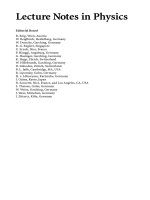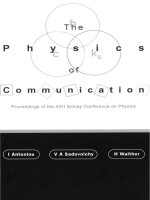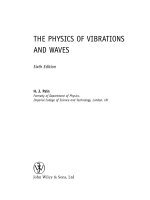- Trang chủ >>
- Khoa Học Tự Nhiên >>
- Vật lý
the physics of semiconductors. an introduction including devices and nanophysics, 2006, p.701
Bạn đang xem bản rút gọn của tài liệu. Xem và tải ngay bản đầy đủ của tài liệu tại đây (16.34 MB, 701 trang )
Marius Grundmann
The Physics of Semiconductors
Marius Grundmann
The Physics of
Semiconductors
An Introduction Including
Devices and Nanophysics
With 587 Figures, 6 in Color, and 36 Tables
123
Marius Grundmann
Institut für Experimentelle Physik II
Universität Leipzig
Linnéstraße 5
04103 Leipzig
e-mail: grundma
Library of Congress Control Number: 2006923434
ISBN-10 3-540-25370-X Springer Berlin Heidelberg New York
ISBN-13 978-3-540-25370-9 Springer Berlin Heidelberg New York
This work is subject to copyright. All rights are reserved, whether the whole or part of the material
is concerned, specifically the rights of translation, reprinting, reuse of illustrations, recitation,
broadcasting, reproduction on microfilm or in any other way, and storage in data banks. Duplication
of this publication or parts thereof is permitted only under the provisions of the German Copyright
Law of September 9, 1965, in its current version, and permission for use must always be obtained from
Springer. Violations are liable for prosecution under the German Copyright Law.
Springer is a part of Springer Science+Business Media
springer.com
© Springer-Verlag Berlin Heidelberg 2006
Printed in Germany
The use of general descriptive names, registered names, trademarks, etc. in this publication does not
imply, even in the absence of a specific statement, that such names are exempt from the relevant
protective laws and regulations and therefore free for general use.
Typesetting: Protago-T
E
X-Production GmbH, Berlin
Produc tion: LE-T
E
XJelonek,Schmidt&VöcklerGbR,Leipzig
Cover design: eStudio Calamar S.L., F. Steinen-Broo, Pau/Girona, Spain
Printed on acid-free paper 57/3100/YL 543210
To Michelle,
Sophia Charlotte
and Isabella Rose
Preface
Semiconductor devices are nowadays commonplace in every household. In the
late 1940s the invention of the transistor was the start of a rapid development
towards ever faster and smaller electronic components. Complex systems are
built with these components. The main driver of this development was the
economical benefit from packing more and more wiring, transistors and func-
tionality on a single chip. Now every human is left with about 100 million
transistors (on average). Semiconductor devices have also enabled economi-
cally reasonable fiber-based optical communication, optical storage and high-
frequency amplification and have only recently revolutionized photography,
display technology and lighting. Along with these tremendous technological
developments, semiconductors have changed the way we work, communicate,
entertain and think. The technological sophistication of semiconductor ma-
terials and devices is progressing continuously with a large worldwide effort
in human and monetary capital, partly evolutionary, partly revolutionary
embracing the possibilities of nanotechnology. For students, semiconductors
offer a rich, diverse and exciting field with a great tradition and a bright
future.
This book is based on the two semester semiconductor physics course
taught at Universit¨at Leipzig. The material gives the students an overview of
the subject as a whole and brings them to the point where they can specialize
and enter supervised laboratory research. For the interested reader some ad-
ditional topics are included in the book that are taught in subsequent, more
specialized courses.
The first semester contains the fundamentals of semiconductor physics
(Part I – Chaps. 1–17). Besides important aspects of solid-state physics such
as crystal structure, lattice vibrations and band structure, semiconductor
specifics such as technologically relevant materials and their properties, elec-
tronic defects, recombination, hetero- and nanostructures are discussed. Semi-
conductors with electric polarization and magnetization are introduced. The
emphasis is put on inorganic semiconductors, but a brief introduction to or-
ganic semiconductors is given in Chap. 16. In Chap. 17 dielectric structures
are treated. Such structures can serve as mirrors, cavities and microcavities
and are a vital part of many semiconductor devices.
The second part (Part II – Chaps. 18–21) is dedicated to semiconduc-
tor applications and devices that are taught in the second semester of the
VIII Preface
course. After a general and detailed discussion of various diode types, their
applications in electrical circuits, photodetectors, solar cells, light-emitting
diodes and lasers are treated. Finally, bipolar and field-effect transistors are
discussed.
The course is designed to provide a balance between aspects of solid-state
and semiconductor physics and the concepts of various semiconductor devices
and their applications in electronic and photonic devices. The book can be
followed with little or no pre-existing knowledge in solid-state physics.
I would like to thank several colleagues for their various contributions to
this book, in alphabetical order (if no affiliation is given, from Universit¨at
Leipzig): Klaus Bente, Rolf B¨ottcher, Volker Gottschalch, Axel Hoffmann
(Technische Universit¨at Berlin), Alois Krost (Otto-von-Guericke Univer-
sit¨at Magdeburg), Michael Lorenz, Thomas Nobis, Rainer Pickenhain, Hans-
Joachim Queisser (Max-Planck-Institut f¨ur Festk¨orperforschung, Stuttgart),
Bernd Rauschenbach (Leibniz-Institut f¨ur Oberfl¨achenmodifizierung,
Leipzig), Bernd Rheinl¨ander, Heidemarie Schmidt, R¨udiger Schmidt-Grund,
Mathias Schubert, Gerald Wagner, Holger von Wenckstern, Michael Ziese,
and Gregor Zimmermann. Their comments, proof reading and graphic mate-
rial improved this work. Also, numerous helpful comments from my students
on my lectures and on preliminary versions of the present text are gratefully
acknowledged. I am also indebted to many other colleagues, in particular
to (in alphabetical order) Gerhard Abstreiter, Zhores Alferov, Levon Asryan,
G¨unther Bauer, Manfred Bayer, Immanuel Broser, J¨urgen Christen, Laurence
Eaves, Ulrich G¨osele, Alfred Forchel, Manus Hayne, Frank Heinrichsdorff,
Fritz Henneberger, Detlev Heitmann, Robert Heitz
†
, Nils Kirstaedter, Fred
Koch, Nikolai Ledentsov, Evgeni Kaidashev, Eli Kapon, Claus Klingshirn,
J¨org Kotthaus, Axel Lorke, Anupam Madhukar, Bruno Meyer, David Mow-
bray, Hisao Nakashima, Mats-Erik Pistol, Fred Pollak, Volker Riede, Hiroyuki
Sakaki, Lars Samuelson, Vitali Shchukin, Maurice Skolnick, Oliver Stier,
Robert Suris, Volker T¨urck, Konrad Unger, Victor Ustinov, Leonid Vorob’jev,
Richard Warburton, Alexander Weber, Eicke Weber, Peter Werner, Ulrike
Woggon, Roland Zimmermann and Alex Zunger, with whom I have worked
closely, had enjoyable discussions with and who have posed questions that
stimulated me. I reserve special thanks for Dieter Bimberg, who supported
me throughout my career. I leave an extra niche – as the Romans did, in or-
der not to provoke the anger of a God missed in a row of statues – for those
who had an impact on my scientific life and that I have omitted to mention.
Leipzig, January 2006 Marius Grundmann
Contents
Abbreviations XXI
Symbols XXVII
Physical Constants XXXI
1 Introduction 1
1.1 Timetable 1
1.2 NobelPrizeWinners 7
1.3 GeneralInformation 9
Part I Fundamentals
2 Bonds 15
2.1 Introduction 15
2.2 CovalentBonds 15
2.2.1 Electron-PairBond 15
2.2.2 sp
3
Bond 15
2.2.3 sp
2
Bond 19
2.3 Ionic Bonds 21
2.4 Mixed Bond 23
2.5 Metallic Bond 25
2.6 van-der-WaalsBond 26
2.7 Hamilton Operator oftheSolid 27
3 Crystals 29
3.1 Introduction 29
3.2 CrystalStructure 29
3.3 Lattice 30
3.3.1 UnitCell 30
3.3.2 Point Group 31
3.3.3 Space Group 33
3.3.4 2DBravaisLattices 34
3.3.5 3DBravaisLattices 34
3.3.6 Polycrystalline Semiconductors 39
XContents
3.3.7 Amorphous Semiconductors 39
3.4 ImportantCrystalStructures 40
3.4.1 Rocksalt Structure 41
3.4.2 CsClStructure 41
3.4.3 DiamondStructure 41
3.4.4 ZincblendeStructure 42
3.4.5 WurtziteStructure 43
3.4.6 ChalcopyriteStructure 45
3.4.7 DelafossiteStructure 46
3.4.8 Perovskite Structure 48
3.4.9 NiAsStructure 48
3.5 Polytypism 48
3.6 ReciprocalLattice 50
3.6.1 ReciprocalLatticeVectors 51
3.6.2 Miller Indices 52
3.6.3 Brillouin Zone 54
3.7 Alloys 54
3.7.1 RandomAlloys 55
3.7.2 Phase Diagram 57
3.7.3 VirtualCrystalApproximation 59
3.7.4 LatticeParameter 59
3.7.5 Ordering 61
4 Defects 63
4.1 Introduction 63
4.2 Point Defects 63
4.3 ThermodynamicsofDefects 65
4.4 Dislocations 67
4.5 StackingFaults 71
4.6 Grain Boundaries 72
4.7 Antiphase andInversionDomains 73
4.8 Disorder 76
5 Mechanical Properties 77
5.1 Introduction 77
5.2 LatticeVibrations 77
5.2.1 MonoatomicLinear Chain 77
5.2.2 Diatomic LinearChain 80
5.2.3 Lattice Vibrations of a Three-Dimensional Crystal . 84
5.2.4 Phonons 86
5.2.5 Localized VibrationalModes 87
5.2.6 PhononsinAlloys 89
5.2.7 Electric FieldCreatedby OpticalPhonons 91
5.3 Elasticity 94
5.3.1 Stress–Strain Relation 94
Contents XI
5.3.2 BiaxialStrain 99
5.3.3 Three-DimensionalStrain 100
5.3.4 Substrate Bending 102
5.3.5 Scrolling 103
5.3.6 Critical Thickness 105
5.4 Cleaving 109
6 Band Structure 111
6.1 Introduction 111
6.2 Bloch’sTheorem 111
6.3 Free-ElectronDispersion 112
6.4 Kronig–PenneyModel 114
6.5 ElectronsinaPeriodicPotential 116
6.5.1 Approximate Solution at the Zone Boundary 117
6.5.2 Solution in the Vicinity of the Zone Boundary 118
6.5.3 Kramer’s degeneracy 119
6.6 Band Structure of Selected Semiconductors 119
6.6.1 Silicon 119
6.6.2 Germanium 119
6.6.3 GaAs 119
6.6.4 GaP 120
6.6.5 GaN 120
6.6.6 LeadSalts 121
6.6.7 Chalcopyrites 122
6.6.8 Delafossites 123
6.6.9 Perovskites 123
6.7 Alloy Semiconductors 124
6.8 Amorphous Semiconductors 125
6.9 Systematics of Semiconductor Bandgaps 125
6.10 TemperatureDependence oftheBandgap 129
6.11 Equation ofElectronMotion 131
6.12 Electron Mass 132
6.12.1 EffectiveMass 132
6.12.2 PolaronMass 135
6.12.3 Nonparabolicity ofElectronMass 136
6.13 Holes 136
6.13.1 HoleConcept 136
6.13.2 HoleDispersionRelation 138
6.13.3 Valence-Band Fine Structure 140
6.14 StrainEffectonthe Band Structure 142
6.14.1 StraineffectonBandEdges 143
6.14.2 Strain Effect on Effective Masses 144
6.15 DensityofStates 144
6.15.1 GeneralBandStructure 144
6.15.2 Free-ElectronGas 145
XII Contents
7 Electronic Defect States 149
7.1 Introduction 149
7.2 FermiDistribution 149
7.3 CarrierConcentration 151
7.4 Intrinsic Conduction 153
7.5 ShallowImpurities,Doping 156
7.5.1 Donors 157
7.5.2 Acceptors 164
7.5.3 Compensation 167
7.5.4 AmphotericImpurities 170
7.5.5 HighDoping 171
7.6 Quasi-FermiLevels 174
7.7 DeepLevels 175
7.7.1 ChargeStates 176
7.7.2 Jahn–TellerEffect 177
7.7.3 Negative-U Center 178
7.7.4 DXCenter 180
7.7.5 EL2Defect 182
7.7.6 Semi-insulating Semiconductors 183
7.7.7 SurfaceStates 184
7.8 Hydrogen in Semiconductors 185
8 Transport 189
8.1 Introduction 189
8.2 Conductivity 190
8.3 Low-Field Transport 191
8.3.1 Mobility 191
8.3.2 Microscopic Scattering Processes 192
8.3.3 IonizedImpurityScattering 193
8.3.4 DeformationPotential Scattering 193
8.3.5 PiezoelectricPotentialScattering 194
8.3.6 PolarOpticalScattering 194
8.3.7 TemperatureDependence 194
8.4 HallEffect 197
8.5 High-FieldTransport 200
8.5.1 Drift-SaturationVelocity 200
8.5.2 VelocityOvershoot 201
8.5.3 ImpactIonization 202
8.6 High-FrequencyTransport 205
8.7 Diffusion 205
8.8 ContinuityEquation 206
8.9 Heat Conduction 207
8.10 CoupledHeatand ChargeTransport 209
8.10.1 SeebeckEffect 209
8.10.2 PeltierEffect 210
Contents XIII
9 Optical Properties 213
9.1 SpectralRegionsand Overview 213
9.2 Reflectionand Diffraction 214
9.3 Electron–PhotonInteraction 216
9.4 Band–BandTransitions 219
9.4.1 JointDensity ofStates 219
9.4.2 DirectTransitions 219
9.4.3 Indirect Transitions 221
9.4.4 UrbachTail 223
9.4.5 Intravalence-BandAbsorption 225
9.4.6 Amorphous Semiconductors 225
9.4.7 Excitons 225
9.4.8 ExcitonPolariton 229
9.4.9 Bound-Exciton Absorption 232
9.4.10 Biexcitons 234
9.4.11 Trions 235
9.4.12 Burstein–Moss Shift 235
9.4.13 BandgapRenormalization 236
9.4.14 Electron–Hole Droplets 238
9.4.15 Two-PhotonAbsorption 239
9.5 ImpurityAbsorption 240
9.6 Free-Carrier Absorption 242
9.7 LatticeAbsorption 245
9.7.1 DielectricConstant 245
9.7.2 Reststrahlenbande 246
9.7.3 Polaritons 248
9.7.4 Phonon–PlasmonCoupling 249
10 Recombination 251
10.1 Introduction 251
10.2 Band–BandRecombination 251
10.2.1 SpontaneousEmission 251
10.2.2 Absorption 252
10.2.3 StimulatedEmission 253
10.2.4 NetRecombinationRate 253
10.2.5 RecombinationDynamics 254
10.2.6 Lasing 256
10.3 Free-Exciton Recombination 256
10.4 Bound-Exciton Recombination 258
10.5 AlloyBroadening 260
10.6 PhononReplica 261
10.7 Donor–Acceptor Pair Transitions 265
10.8 Inner-Impurity Recombination 267
10.9 Auger Recombination 267
10.10 Band–ImpurityRecombination 268
XIV Contents
10.11 FieldEffect 272
10.11.1 ThermallyActivatedEmission 272
10.11.2 Direct Tunneling 273
10.11.3 Assisted Tunneling 273
10.12 Multilevel Traps 273
10.13 SurfaceRecombination 274
10.14 Excess-Carrier Profiles 274
11 Heterostructures 277
11.1 Introduction 277
11.2 GrowthMethods 277
11.3 Material Combinations 280
11.3.1 Pseudomorphic Structures 280
11.3.2 Heterosubstrates 280
11.4 BandLineupinHeterostructures 285
11.5 EnergyLevelsinHeterostructures 286
11.5.1 QuantumWell 286
11.5.2 Superlattices 293
11.5.3 Single Heterointerface Between Doped Materials . . 293
11.6 RecombinationinQuantumWells 295
11.7 IsotopeSuperlattices 299
11.8 WaferBonding 300
12 External Fields 303
12.1 Electric Fields 303
12.1.1 BulkMaterial 303
12.1.2 QuantumWells 305
12.2 Magnetic Fields 306
12.2.1 Free-Carrier Absorption 307
12.2.2 EnergyLevelsinBulkCrystals 308
12.2.3 EnergyLevelsina2DEG 309
12.2.4 Shubnikov–de Haas Oscillations 310
12.3 QuantumHall Effect 313
12.3.1 IntegralQHE 313
12.3.2 FractionalQHE 317
12.3.3 Weiss Oscillations 318
13 Nanostructures 321
13.1 Introduction 321
13.2 QuantumWires 321
13.2.1 PreparationMethods 321
13.2.2 Quantization in Two-Dimensional Potential Wells . 328
13.3 QuantumDots 328
13.3.1 Quantization in Three-Dimensional
PotentialWells 328
Contents XV
13.3.2 ElectricalandTransport Properties 331
13.3.3 Self-Assembled Preparation 336
13.3.4 OpticalProperties 341
14 Polarized Semiconductors 345
14.1 Introduction 345
14.2 SpontaneousPolarization 345
14.3 Ferroelectricity 346
14.3.1 Materials 348
14.3.2 SoftPhononMode 348
14.3.3 Phase Transition 348
14.3.4 Domains 352
14.3.5 OpticalProperties 353
14.4 Piezoelectricity 353
15 Magnetic Semiconductors 359
15.1 Introduction 359
15.2 Magnetic Semiconductors 359
15.3 Diluted Magnetic Semiconductors 361
15.4 Spintronics 365
15.4.1 SpinTransistor 366
15.4.2 SpinLED 367
16 Organic Semiconductors 369
16.1 Materials 369
16.2 Properties 371
17 Dielectric Structures 375
17.1 Photonic-BandgapMaterials 375
17.1.1 Introduction 375
17.1.2 General1DScatteringTheory 375
17.1.3 Transmission of an N-PeriodPotential 377
17.1.4 TheQuarter-WaveStack 379
17.1.5 Formation ofa3DBandStructure 382
17.1.6 DefectModes 385
17.1.7 Coupling toanElectronicResonance 387
17.2 MicroscopicResonators 390
17.2.1 Microdiscs 390
17.2.2 PurcellEffect 392
17.2.3 Deformed Resonators 393
17.2.4 Hexagonal Cavities 395
XVI Contents
Part II Applications
18 Diodes 401
18.1 Introduction 401
18.2 Metal–Semiconductor Contacts 402
18.2.1 Band Diagram in Equilibrium 402
18.2.2 Space-ChargeRegion 407
18.2.3 SchottkyEffect 409
18.2.4 Capacitance 410
18.2.5 Current–VoltageCharacteristic 412
18.2.6 Ohmic Contacts 421
18.2.7 Metal Contacts to Organic Semiconductors 424
18.3 Metal–Insulator–Semiconductor Diodes 425
18.3.1 BandDiagramfor IdealMISDiode 427
18.3.2 Space-ChargeRegion 428
18.3.3 Capacity 432
18.3.4 Nonideal MISDiode 435
18.4 BipolarDiodes 435
18.4.1 BandDiagram 436
18.4.2 Space-ChargeRegion 437
18.4.3 Capacitance 442
18.4.4 Current–VoltageCharacteristics 443
18.4.5 Breakdown 454
18.5 Applicationsand SpecialDiodeDevices 457
18.5.1 Rectification 457
18.5.2 Frequency Mixing 460
18.5.3 VoltageRegulator 462
18.5.4 Zener Diodes 463
18.5.5 Varactors 463
18.5.6 Fast-RecoveryDiodes 466
18.5.7 Step-Recovery Diodes 466
18.5.8 pin-Diodes 468
18.5.9 Tunneling Diodes 469
18.5.10 BackwardDiodes 471
18.5.11 HeterostructureDiodes 471
19 Light-to-Electricity Conversion 473
19.1 Photocatalysis 473
19.2 Photoconductors 475
19.2.1 Introduction 475
19.2.2 Photoconductivity Detectors 475
19.2.3 Electrophotography 477
19.2.4 QWIPs 477
19.2.5 BlockedImpurity-Band Detectors 482
Contents XVII
19.3 Photodiodes 484
19.3.1 Introduction 484
19.3.2 pnPhotodiodes 484
19.3.3 pinPhotodiodes 487
19.3.4 Position-SensingDetector 489
19.3.5 MSMPhotodiodes 490
19.3.6 Avalanche Photodiodes 495
19.3.7 Traveling-WavePhotodetectors 498
19.3.8 ChargeCoupledDevices 501
19.3.9 Photodiode Arrays 509
19.4 Solar Cells 511
19.4.1 Solar Radiation 511
19.4.2 Ideal SolarCells 513
19.4.3 RealSolarCells 516
19.4.4 DesignRefinements 516
19.4.5 Solar-CellTypes 517
19.4.6 CommercialIssues 520
20 Electricity-to-Light Conversion 523
20.1 RadiometricandPhotometricQuantities 523
20.1.1 RadiometricQuantities 523
20.1.2 PhotometricQuantities 523
20.2 Scintillators 524
20.2.1 CIEChromaticityDiagram 525
20.2.2 DisplayApplications 528
20.2.3 RadiationDetection 528
20.2.4 Luminescence Mechanisms 530
20.3 Light-Emitting Diodes 531
20.3.1 Introduction 531
20.3.2 SpectralRanges 531
20.3.3 QuantumEfficiency 532
20.3.4 DeviceDesign 533
20.4 Lasers 539
20.4.1 Introduction 539
20.4.2 Applications 542
20.4.3 Gain 543
20.4.4 OpticalMode 547
20.4.5 LossMechanisms 552
20.4.6 Threshold 554
20.4.7 SpontaneousEmissionFactor 555
20.4.8 OutputPower 555
20.4.9 TemperatureDependence 559
20.4.10 Mode Spectrum 560
20.4.11 LongitudinalSingle-ModeLasers 560
20.4.12 Tunability 562
XVIII Contents
20.4.13 Modulation 564
20.4.14 Surface-emittingLasers 568
20.4.15 Optically Pumped Semiconductor Lasers 571
20.4.16 QuantumCascadeLasers 573
20.4.17 Hot-Hole Lasers 573
20.5 Semiconductor Optical Amplifiers 575
21 Transistors 577
21.1 Introduction 577
21.2 BipolarTransistors 577
21.2.1 CarrierDensityandCurrents 579
21.2.2 CurrentAmplification 582
21.2.3 Ebers–MollModel 583
21.2.4 Current–VoltageCharacteristics 585
21.2.5 Basic Circuits 588
21.2.6 High-FrequencyProperties 589
21.2.7 HeterobipolarTransistors 590
21.2.8 Light-emitting Transistors 590
21.3 Field-EffectTransistors 592
21.4 JFETand MESFET 593
21.4.1 GeneralPrinciple 593
21.4.2 StaticCharacteristics 594
21.4.3 Normally OnandNormallyOffFETs 597
21.4.4 Field-Dependent Mobility 598
21.4.5 High-FrequencyProperties 601
21.5 MOSFETs 601
21.5.1 Operation Principle 601
21.5.2 Current–VoltageCharacteristics 602
21.5.3 MOSFETTypes 606
21.5.4 ComplementaryMOS 608
21.5.5 Large-ScaleIntegration 610
21.5.6 NonvolatileMemories 614
21.5.7 Heterojunction FETs 615
21.6 Thin-Film Transistors 619
Part III Appendices
A Tensors 623
B Kramers–Kronig Relations 627
C Oscillator Strength 629
D Quantum Statistics 635
Contents XIX
EThek· p Perturbation Theory 639
F Effective-Mass Theory 643
References 645
Index 669
Abbreviations
2DEG two-dimensional electron gas
AAAS American Association for the Advancement of Science
AB antibonding (position)
ac alternating current
AFM atomic force microscopy
AIP American Institute of Physics
AM air mass
APD antiphase domain
APD avalanche photodiode
APS American Physical Society
AR antireflection
ASE amplified spontaneous emission
AVS American Vacuum Society (The Science &
Technology Society)
BC bond center (position)
bcc body-centered cubic
BEC Bose–Einstein condensation
BGR bandgap renormalization
CAS calorimetric absorption spectroscopy
CCD charge coupled device
CD compact disc
CEO cleaved-edge overgrowth
CIE Commission Internationale de l’
´
Eclairage
CIS CuInSe
2
material
CL cathodoluminescence
CMOS complementary metal–oxide–semiconductor
CMY cyan-magenta-yellow (color system)
COD catastrophical optical damage
CPU central processing unit
CRT cathode ray tube
CVD chemical vapor deposition
XXII Abbreviations
cw continuous wave
CZ Czochralski (growth)
DAP donor–acceptor pair
DBR distributed Bragg reflector
dc direct current
DFB distributed feedback
DH(S) double heterostructure
DLTS deep level transient spectroscopy
DMS diluted magnetic semiconductor
DOS density of states
DPSS diode-pumped solid-state (laser)
DRAM dynamic random access memory
DVD digital versatile disc
EEPROM electrically erasable programmable read-only memory
EHL electron–hole liquid
EL electroluminescence
ELO epitaxial lateral overgrowth
EMA effective mass approximation
EPROM erasable programmable read-only memory
ESF extrinsic stacking fault
EXAFS extended X-ray absorption fine structure
fcc face-centered cubic
FeRAM ferroelectric random access memory
FET field-effect transistor
FIR far infrared
FKO Franz–Keldysh oscillation
FPA focal plane array
FQHE fractional quantum Hall effect
FWHM full width at half-maximum
FZ float-zone (growth)
GLAD glancing-angle deposition
GRINSCH graded-index separate confinement heterostructure
GSMBE gas-source molecular beam epitaxy
HBT heterobipolar transistor
hcp hexagonally close packed
HCSEL horizontal cavity surface-emitting laser
HEMT high electron mobility transistor
HIGFET heterojunction insulating gate FET
HJFET heterojunction FET
hh heavy hole
Abbreviations XXIII
HOMO highest occupied molecular orbital
HR high reflection
HRTEM high-resolution transmission electron microscopy
HWHM half-width at half-maximum
IC integrated circuit
IDB inversion domain boundary
IF intermediate frequency
IPAP Institute of Pure and Applied Physics, Tokyo
IQHE integral quantum Hall effect
IR infrared
ISF intrinsic stacking fault
ITO indium tin oxide
JDOS joint density of states
JFET junction field-effect transistor
KKR Kramers–Kronig relation
KTP KTiOPO
4
material
LA longitudinal acoustic (phonon)
LCD liquid crystal display
LDA local density approximation
LEC liquid encapsulated Czochralski (growth)
LED light-emitting diode
lh light hole
LO longitudinal optical (phonon), local oscillator
LPE liquid phase epitaxy
LPCVD low-pressure chemical vapor deposition
LPP longitudinal phonon plasmon (mode)
LST Lyddane–Sachs–Teller (relation)
LT low temperature
LUMO lowest unoccupied molecular orbital
LVM local vibrational mode
MBE molecular beam epitaxy
MEMS micro-electro-mechanical system
MESFET metal–semiconductor field-effect transistor
MIGS midgap (surface) states
MIOS metal–insulator–oxide–semiconductor
MIR mid-infrared
MIS metal–insulator–semiconductor
MHEMT metamorphic HEMT
ML monolayer
MMIC millimeter-wave integrated circuit
XXIV Abbreviations
MO master oscillator
MODFET modulation-doped FET
MOMBE metal-organic molecular beam epitaxy
MOPA master oscillator power amplifier
MOS metal–oxide–semiconductor
MOSFET metal–oxide–semiconductor field-effect transistor
MOVPE metal-organic chemical vapor deposition
MRS Material Research Society
MS metal–semiconductor (diode)
MSM metal–semiconductor–metal (diode)
MWQ multiple quantum well
NDR negative differential resistance
NEP noise equivalent power
NIR near infrared
NMOS n-channel metal–oxide–semiconductor (transistor)
NTSC national television standard colors
OPSL optically pumped semiconductor laser
PA power amplifier
PBG photonic bandgap
pc primitive cubic
PFM piezoresponse force microscopy
PHEMT pseudomorphic HEMT
PL photoluminescence
PLD pulsed laser deposition
PLE photoluminescence excitation (spectroscopy)
PMMA poly-methyl methacrylate
PMOS p-channel metal–oxide–semiconductor (transistor)
PPC persistent photoconductivity
PPLN perodically poled lithium niobate
PV photovoltaic
PWM pulsewidth modulation
PZT PbTi
x
Zr
1−x
O
3
material
QCL quantum cascade laser
QCSE quantum confined Stark effect
QD quantum dot
QHE quantum Hall effect
QW quantum well
QWIP quantum-well intersubband photodetector
QWR quantum wire
Abbreviations XXV
RAM random access memory
RAS reflection anisotropy spectroscopy
REI random element isodisplacement
RF radio frequency
RGB red-green-blue (color system)
RHEED reflection high-energy electron diffraction
RKKY Ruderman–Kittel–Kasuya–Yoshida (interaction)
rms root mean square
ROM read-only memory
SAGB small-angle grain boundary
SAM separate absorption and amplification (structure)
sc simple cubic
SCH separate confinement heterostructure
SEL surface-emitting laser
SEM scanning electron microscopy
SET single-electron transistor
SGDBR sampled grating distributed Bragg reflector
SHG second-harmonic generation
si semi-insulating
SIA Semiconductor Industry Association
SIMS secondary ion mass spectroscopy
SL superlattice
s-o spin-orbit (or split-off)
SOA semiconductor optical amplifier
SPD spectral power distribution
SPIE International Society for Optical Engineering
SPS short-period superlattice
sRGB standard RGB
SRH Shockley–Read–Hall (kinetics)
SSR side-mode suppression ratio
STM scanning tunneling microscopy
TA transverse acoustic (phonon)
TCO transparent conductive oxide
TE transverse electric (polarization)
TEGFET two-dimensional electron gas FET
TEM transmission electron microscopy
TES two-electron satellite
TF thermionic field emission
TFT thin-film transistor
TM transverse magnetic (polarization)
TO transverse optical (phonon)
TOD turn-on delay (time)
TPA two-photon absorption
XXVI Abbreviations
UHV ultrahigh vacuum
UV ultraviolet
VCA virtual crystal approximation
VCO voltage-controlled oscillator
VCSEL vertical-cavity surface-emitting laser
VFF valence force field
VGF vertical gradient freeze (growth)
VIS visible
VLSI very large scale integration
WGM whispering gallery mode
WKB Wentzel–Kramer–Brillouin (approximation or method)
WS Wigner–Seitz (cell)
XSTM cross-sectional STM
Symbols
α Madelung constant, disorder parameter,
linewidth enhancement factor
α(ω) absorption coefficient
α
m
mirror loss
α
n
electron ionization coefficient
α
p
hole ionization coefficient
β used as abbreviation for e/(k
B
T ), spontaneous
emission coefficient
γ, Γ broadening parameter
γ
1
, γ
2
, γ
3
Luttinger parameter
Δ
0
spin-orbit splitting
(ω) dielectric function
0
permittivity of vacuum
r
relative dielectric function
xy
strain components
η quantum efficiency
η
d
differential quantum efficiency
η
w
wall-plug efficiency
Θ
D
Debye temperature
κ imaginary part of index of refraction, heat conductivity
λ wavelength
μ mobility
μ
0
magnetic susceptibility of vacuum
μ
h
hole mobility
μ
n
electron mobility
ν frequency
Π Peltier coefficient
ρ mass density, charge density, resistivity
σ standard deviation, conductivity
σ
n
electron capture cross section
σ
p
hole capture cross section
σ
P
polarization charge
σ
xy
stress components
τ lifetime, time constant
XXVIII Symbols
φ phase
φ
Bn
Schottky barrier height
χ electron affinity, electric susceptibility
χ(r) envelope wavefunction
Ψ(r) wavefunction
ω angular frequency
Ω interaction parameter
a hydrostatic deformation potential
a accelaration
A area
A, A vector potential
A
∗
Richardson constant
A
∗∗
effective Richardson constant
a
0
(cubic) lattice constant
b bowing parameter, deformation potential
b Burger’s vector
B bimolecular recombination coefficient, bandwidth
B, B magnetic field
c velocity of light in vacuum, lattice constant (along c-axis)
C capacity, spring constant
C
n
, C
p
Auger recombination coefficient
C
ij
elastic constants
d distance, shear deformation potential
D density of states, diffusion coefficient
D, D displacement field
D
e
(E) electron density of states
D
h
(E) hole density of states
D
n
electron diffusion coefficient
D
p
hole diffusion coefficient
e elementary charge
E energy
E, E, E electric field
E
A
energy of acceptor level
E
b
A
acceptor ionization energy
E
C
energy of conduction-band edge
E
D
energy of donor level
E
b
D
donor ionization energy
E
F
Fermi energy
E
F
n
electron quasi-Fermi energy
E
F
p
hole quasi-Fermi energy
E
g
bandgap
E
P
energy parameter
E
V
energy of valence-band edge
E
X
exciton energy









